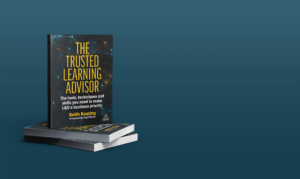On the Road to Continuous Improvement
Learner feedback was positive. Survey results were good. General Motors turned to design thinking to discover how they could be even better.
-
 Keith Keating
Keith Keating
- November 1, 2019
The Center of Learning (COL) is the training organization within General Motors that focuses on supporting dealership and field personnel in achieving their sales and market share targets through training initiatives. CoL takes an evidence-based approach to building learning solutions, employing an overarching needs assessment and measurement strategy that data analysts and statisticians lead, which specifies the standard practices for all levels of measurement.
In 2018, COL was receiving consistent positive feedback from learners and strong Kirkpatrick Level 1 survey results. Plus, its initiatives demonstrated positive business results in terms of increased vehicle sales. On the surface, the training team was performing successfully, and the learners were satisfied with training. Recognizing that the way learners learn has been evolving, COL Senior Manager Sally Vlietstra asked her team, “How can we best support our learners in their professional development?” The team recognized this could be a great opportunity to use design thinking to further understand its learners.
Nuts and bolts
Desgn thinking is a five-phased set of principles for problem finding and creative problem solving. It’s a methodology that encourages a focus on people and leads to human-centered products, services, and internal processes. Design thinking helps to unlock users’ needs and problems, even when the users may not know what the problem is or are unable to clearly articulate it. The five phases are empathy, define, ideate, prototype, and test. The design thinking team comprised 10 individuals from COL. The team identified five key dealership roles as the target roles for the initiative. Through data analysis on dealership performance level, technology usage, tenure in role, and dealership workforce size, a team member also identified an appropriate sample size. Next, the team divided into five pairs, matching the five GM regions across the United States, and began their journey.Empathy: Understanding the learner
The design thinking team spent several days preparing for empathy interviews. This preparation included brainstorming interview questions, creating interview themes, refining questions after mock interviews, creating the interview script, and ensuring the team was comfortable with the questions and the anatomy of the interview process. The team conducted 75 interviews across the United States. At the end of each interview day, each pair used de sign thinking tools, including an empathy map, to begin to analyze the information collected. After they completed inter views, the pairs returned and began their data synthesis.Define: Developing the problem statement
During the debrief, each pair shared its empathy map, key findings, quotes, and recurring themes. They used whiteboards and sticky notes to capture key messages. Groupings of responses began to evolve. At the end of the debrief, recurring messages and themes from the learners filled the room. Each pair synthesized its learner personas, creating five master personas-one per job role. The design thinking team spent several more hours reviewing previously captured notes, adding missed insights, and grouping the analysis and feedback into themes, Discussions continued throughout the day until the team members settled on the key themes they believed represented the learners’ voice. The team found that learners unanimously agreed that the current product training curriculum met their needs. That was great confirmation for CoL, given that product training had been its core focus. However, the team identified additional development needs during the synthesis process, resulting in six key themes:- Learners want soft skills training – selling, negotiation, and relationship building.
- Learners need inspiration and motivation to gain competency.
- Learners desire training that is personalized based on their experience and interests.
- Learners want flexibility to learn what they want but with enough structure to understand where they are going.
- Learners prefer hands-on and inter active learning so they can apply as they learn.
- Learners recognize the need for learning but feel time spent training is time away from selling.
- How might we give learners experiential ways to learn on their own?
- How might we enable people to learn from others on the job?
- How might we change the perception of what training means?
- How might we provide training in the moment of need that doesn’t take them away from their job?
Ideate: Brainstorming and creating solutions
To create a diverse, unbiased approach for brainstorming, the team invited eight new individuals to participate in the next phase: a two-day brainstorming session that included learners and trainers. The team chose a four-step brain storming process:- idea share
- sketch and storyboard
- vote
- plot an impact and feasibility prioritization matrix.
- high risk/high reward
- stars
- quick hits
- lower priority.




